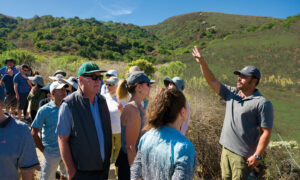 The sandstone cliffs and lush canyons within and around Irvine tell stories dating back 80 million years, encompassing eras in which dinosaurs roamed the coast and whales swam in an ocean covering what later became the Santa Ana Mountains.
The sandstone cliffs and lush canyons within and around Irvine tell stories dating back 80 million years, encompassing eras in which dinosaurs roamed the coast and whales swam in an ocean covering what later became the Santa Ana Mountains.
While hikers may appreciate the spectacular beauty of this undeveloped land stretching from the mountains to the sea, scientists consider it an outdoor classroom where nature is constantly revealing new secrets.
At its heart are roughly 37,000 acres of open space that both federal and state agencies have designated a “Natural Landmark” in recognition of its rare habitats and geology.
The Landmarks, as they are now known, are part of some 57,500 acres – more than half of The Irvine Ranch – that Irvine Company has dedicated to be preserved forever. The designated area is larger than some national parks, including Bryce Canyon in Utah and Pinnacles in Central California, yet is within a 30-minute drive for more than 3 million people.
“The Landmarks have all the beauty and specialness of a national park, but you don’t need an airplane ticket to get there,” says Michael O’Connell, founding president of the nonprofit Irvine Ranch Conservancy (IRC), which helps manage the land. “You can take a phenomenal hike and get home in time to sleep in your own bed.”
So why isn’t the open space a national park?
Unlike national parks, which must be owned by the federal government, the Orange County open space is owned by about a half-dozen public entities, including the County of Orange, the city of Irvine, the city of Newport Beach and California State Parks. It is the result of gifts of land made over time as Irvine Company moved large parcels of land from private to public and local control.
In search of a way to acknowledge the area’s singular identity, despite its multiple owners, Irvine Company discovered the U.S. National Park Service’s National Natural Landmarks program, which promotes conservation of exceptional habitats and geology on both public and private land. Other landmark sites include Diamond Head in Hawaii and the Torrey Pines State Reserve in San Diego County.
What followed, over many months beginning in 2004, was a rigorous evaluation of the Irvine Ranch open space. Irvine Company hired four independent scientists to assess the land for its biological and geological features, after which the National Park Service contracted six other independent scientists to review their work.
In 2006, the Secretary of the Interior and U.S. National Parks Service designated the 37,000 acres as a National Natural Landmark, and in 2008, California created a similar natural landmark program, naming the Irvine Ranch wilderness as its first site.









